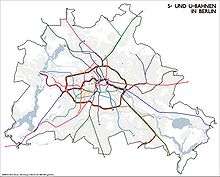Bus transport in Berlin
Bus transport is the oldest public transport service in Berlin, the capital city of Germany, having been introduced in 1846. Since 1929, services have been operated by Berliner Verkehrsbetriebe (BVG), although during the Cold War-era division of the city they operated in West Berlin only. BVG's fleet consists of 1,300 vehicles, which cover 300,000 kilometres per day.
 | |
.jpg) MAN Lion's City DD double decker bus | |
| Overview | |
|---|---|
| Locale | Berlin, Germany |
| Transit type | Public bus transport |
| Number of lines | 329 (+39 night lines) |
| Operation | |
| Began operation | 1846 |
| Operator(s) | Berliner Verkehrsbetriebe |
| Number of vehicles | MAN Lion's City, MAN ND 202 |
| Technical | |
| System length | 1,662 km (1,033 mi) |
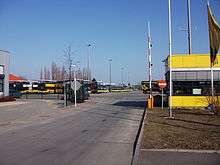
Alt-Hohenschönhausen
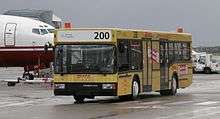


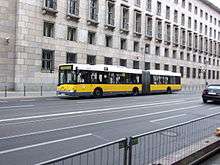
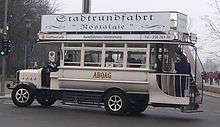
History
30 October 1846 saw the first bus services from the Concessionierte Berliner Omnibus-Compagnie. In 1868, a new company was created, the ABOAG (Allgemeinen Berliner Omnibus Actien Gesellschaft) which on 1 January 1929 merged with other Berlin public transport companies to create the BVG.
After the opening of Berlin Wall, the transport companies were no longer able to cope up with the traffic, and so once again, solo buses by other transport companies and 100 hired coaches were used. The 3-digit numbering system was unified and implemented on June 2, 1991, just before the reunification of BVG in 1 January 1992.
Routes
Normal buses
Normal bus routes (![]()
Each bus line has a 3-digit number. The second digit indicates the borough in which the line runs:
- 0 = across more than 1 or 2 boroughs
- 1 = for the former boroughs of Wilmersdorf and Zehlendorf
- 2 = for the district of Reinickendorf
- 3 = for the district of Spandau
- 4 = for the districts of Mitte and Friedrichshain-Kreuzberg
- 5 = for the district of Pankow and the former one of Hohenschönhausen
- 6 = for the district of Treptow-Köpenick
- 7 = for the districts of Tempelhof-Schöneberg and Neukölln
- 8 = for the former district of Steglitz
- 9 = for the district of Marzahn-Hellersdorf and the former one of Lichtenberg
MetroBus
As for the MetroTram lines, there are 17 MetroBus (![]()
The list of Metrobus routes are:
- M11: Dahlem-Dorf - Schöneweide
- M19: Grunewald - Mehringdamm
- M21: Rosenthal - Jungfernheide
- M27: Pankow - Jungfernheide
- M29: Grunewald - Hermannplatz
- M32: Rathaus Spandau - Dallgow-Döberitz, Havelpark
- M37: Spandau - Staaken
- M41: Sonnenallee - Hauptbahnhof
- M44: Buckow - Hermannstraße
- M45: Spandau - Zoologischer Garten
- M46: Zoologischer Garten - Britz-Süd
- M48: Zehlendorf - Alexanderplatz
- M49: Heerstraße/Nennhauser Damm - Zoologischer Garten
- M76: Walter-Schreiber-Platz - Lichtenrade
- M77: Marienfelde, Waldsassener Straße - Alt-Mariendorf
- M82: Marienfelde, Waldsassener Straße - Rathaus Steglitz
- M85: Lichterfelde Süd - Hauptbahnhof
ExpressBus
The express buses (![]()
- X7: Schönefeld - Rudow
- X9: Zoologischer Garten - Tegel Airport
- X10: Zoologischer Garten - Teltow, Rammrath-Brücke
- X11: Krumme Lanke - Schöneweide
- X21: Märkisches Viertel, Quickborner Straße - U Jakob-Kaiser-Platz
- X33: Märkisches Viertel, Wilhelmsruher Damm - Rathaus Spandau
- X34: Kladow - Zoologischer Garten
- X36: Rathaus Spandau - Haselhorst
- X49: Staaken - Messe Nord/ICC
- X54: Pankow - Hellersdorf
- X69: Marzahn - Köpenick, Müggelschlößchenweg
- X76: Walter-Schreiber-Platz - Lichtenrade
- X83: Königin-Luise-Straße/Clayallee - Lichtenrade
Other services
Apart from the service buses managed by BVG and other local companies, in the city there are hundreds of private tourist coaches. The main bus station of Berlin is the Zentraler Omnibusbahnhof Berlin ("Central Omnibus Station"), also known as ZOB.[5] It is located in Charlottenburg-Wilmersdorf and linked to the stations of Kaiserdamm (U-Bahn) and Messe Nord/ICC[6] (S-Bahn).
In popular culture
On 18 February 2011 MR Software released "OMSI - The Bus Simulator" (also known as "OMSI - Der Omnibussimulator") for Windows. It is a bus simulator set in the late 1980s in West Berlin that features the MAN SD200 and MAN SD202 double-decker buses with a complex set of functions and made in various years. The player operates these buses along line 92 (now M37) that served the Staaken, Wilhelmstadt, Altstadt, and Falkenhagener Feld localities in the borough of Spandau. And on 11 December 2013. MR Software also released “OMSI 2 - The Bus Simulator” for Windows. It is the sequel to OMSI - The Bus Simulator. It features the MAN NL202 and the MAN NG272. The player can enjoy the bus lines 5 (now 130), 92 (now M37) and other add-ons which is community developed. It is sold on Aerosoft, Steam (service) and Halycon.
Fleet
BVG Bus Fleet
As of 2015, the BVG bus fleet consisted of 1300 buses.
Single Decker
| Quantity | Manufacturer | Type | Passengers | Length | Footnotes | Photo | |
|---|---|---|---|---|---|---|---|
| 77 | Mercedes-Benz | EN02 Citaro | 60-70 | 12 m | |||
| 9 | MAN | EN03 Lion's City A21 | 60-70 | 12 m | * To be retired by 2017-2019. | ||
| 30 | Mercedes-Benz | EN05 Citaro | 60-70 | 12 m | |||
| 80 | Mercedes-Benz | EN06 Citaro | 60-70 | 12 m |  | ||
| 150 | Mercedes-Benz | EN09 Citaro LE | 60-70 | 12 m | |||
| 2 | VDL | EN12 Citea LLE-120 | 60-70 | 12 m | |||
| 40 | VDL | EN15 Citea LLE-120 | 70 | 12 m |  | ||
| 4 | Solaris | EN15 Urbino 12 electric | 60-70 | 12 m | Electric Bus |  | |
| 406 | |||||||
Lengthened Bus
| Quantity | Manufacturer | Type | Passengers | Length | Footnotes | Photo |
|---|---|---|---|---|---|---|
| 67 | Mercedes-Benz | LN02 Citaro L | 15 m |  | ||
| 67 | ||||||
Bendy Bus or Articulated Bus
| Quantity | Manufacturer | Type | Passengers | Length | Footnotes | Photo | |
|---|---|---|---|---|---|---|---|
| 32 | MAN | GN03 Lion´s City G A23 | less than 99 | 18 m | * To be retired by 2017-2019. | ||
| 36 | Mercedes-Benz | GN03 Citaro G | less than 99 | 18 m | |||
| 130 | Solaris | GN05 Urbino 18 | less than 99 | 18 m |  |
* 6 buses have been solded to Bratislava. | |
| Solaris | GN07 Urbino 18 | less than 99 | 18 m |  | |||
| 46 | Solaris | GN08 Urbino 18 | 99 | 18 m |  | ||
| 40 | Solaris | GN09 Urbino 18 | 99 | 18 m |  | ||
| 70[7] | Scania | GN14 Citywide LFA | 99 | 18 m |  | ||
| Scania | GN15 Citywide LFA | 99 | 18 m |  | |||
| 416 | |||||||
Double Decker
| Quantity | Manufacturer | Type | Passengers | Length | Footnotes | Photo |
|---|---|---|---|---|---|---|
| 1 | MAN | DL04 Lion’s City DD | 110 | 13,7 m | ||
| 103 | MAN | DL05 Lion’s City DD | 110 | 13,7 m | .jpg) | |
| 103 | MAN | DL07 Lion’s City DD | 110 | 13,7 m | 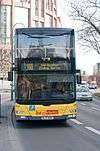 | |
| 105 | MAN | DL08 Lion’s City DD | 110 | 13,7 m | .jpg) | |
| 104 | MAN | DL09 Lion’s City DD | 110 | 13,7 m | ||
| 1[8] | VDL | DN15 Citea DLF 114 | 97 | 11,4 m | Prototype |  |
| 1[9] | Scania | DN15 Citywide LFDD | 88 | 10,9 m | Prototype |  |
| Alexander Dennis | Enviro 500 MMC | 12.9 m | Prototype (demonstration only) | |||
| 418[10] | ||||||
Future Bus
| Quantity | Manufacturer | Type | Passengers | Length | Footnotes | Photo |
|---|---|---|---|---|---|---|
| 200 | Alexander Dennis | Enviro500 MMC | 80 Seated | 13.8m | Minimum 70[11] Option for 430[12] | |
| 200 | ||||||
References
- (in German) Bus (normal lines) page on BVG website
- (in German) MetroBus page on BVG website
- (in German) ExpressBus page on BVG website
- (in German) Night buses page on BVG website
- Berlin ZOB location on Google Maps
- Named Witzleben until 2002
- "Archived copy". Archived from the original on 2016-03-04. Retrieved 2015-10-22.CS1 maint: archived copy as title (link)
- http://www.bvg.de/de/Aktuell/Newsmeldung?newsid=880
- https://www.bvg.de/de/Aktuell/Newsmeldung?newsid=460
- http://unternehmen.bvg.de/de/Unternehmen/Profil/Bus/Fahrzeuge
- https://www.bvg.de/de/Aktuell/Newsmeldung?newsid=2854
- https://www.alexander-dennis.com/media/news/2018/october/alexander-dennis-wins-berlin-contract-for-new-double-decker-fleet/#:~:text=Leading%20British%20bus%20manufacturer%20Alexander,three%2Daxle%20double%20deck%20buses.&text=BVG%20operates%20around%201%2C500%20buses,alone%20transported%20441%20million%20passengers.
Literature
- Dieter Gammrath, Hein Jung: "Berliner Omnibusse". Alba, Düsseldorf 1988, ISBN 3-87094-334-3
- Gammrath, Jung, Schmiedeke: "Berliner Omnibusse". Alba, Düsseldorf 1999, ISBN 3-87094-359-9
External links
| Wikimedia Commons has media related to Bus transport in Berlin. |
